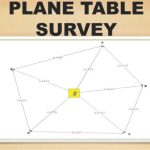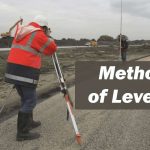
Elevation measurements
Elevation measurements involve measurements in vertical plane. It is also known as levelling. It may be defined as the art of determining the elevations of given points above or below a datum line or establishing given points of required heights above or below the datum line.
OBJECT AND USES OF LEVELLING
As stated in the definition of levelling, the object is
(i) To determine the elevations of given points with respect to a datum
(ii) To establish the points of required height above or below the datum line.
Uses of levelling are
(i) To determine or to set the plinth level of a building.
(ii) To decide or set the road, railway, canal or sewage line alignment.
(iii) To determine or to set various levels of dams, towers, etc.
(iv) To determine the capacity of a reservoir.
TERMS USED IN LEVELLING
Before studying the art of levelling, it is necessary to clearly understand the following terms used in levelling:
1. Level Surface: A surface parallel to the mean spheroid of the earth is called a level surface and the line drawn on the level surface is known as a level line. Hence all points lying on a level surface are equidistant from the centre of the earth.
2. Horizontal Surface: A surface tangential to level surface at a given point is called horizontal surface at that point. Hence a horizontal line is at right angles to the plumb line at that point
3. Vertical Line: A vertical line at a point is the line connecting the point to the centre of the earth. It is the plumb line at that point. Vertical and horizontal lines at a point are at right angles to each other
4. Datum: The level of a point or the surface with respect to which levels of other points or planes are calculated, is called a datum or datum surface.
5. Mean Sea Level (MSL): MSL is the average height of the sea for all stages of the tides. At any particular place MSL is established by finding the mean sea level (free of tides) after averaging tide heights over a long period of at least 19 years. In India MSL used is that established at Karachi, presently, in Pakistan. In all important surveys this is used as datum.
6. Reduced Levels (RL): The level of a point taken as height above the datum surface is known as RL of that point.
7. Benchmarks: A benchmark is a relatively permanent reference point, the elevation of which is known (assumed or known w.r.t. MSL). It is used as a starting point for levelling or as a point upon which to close for a check. The following are the different types of benchmarks used in surveying:
(a) GTS benchmarks
(b) Permanent benchmarks
(c) Arbitrary benchmarks and
(d) Temporary benchmarks.
(a) GTS Benchmark: The long form of GTS benchmark is Great Trigonometrical Survey
Benchmark. These benchmarks are established by national agency. In India, the department of Survey of India is entrusted with such works. GTS benchmarks are established all over the country with highest precision survey, the datum being mean sea level. A bronze plate provided on the top of a concrete pedestal with elevation engraved on it serves as benchmark. It is well protected with masonry structure built around it so that its position is not disturbed by animals or by any unauthorised person. The position of GTS benchmarks are shown in the topo sheets published.
(b) Permanent Benchmark: These are the benchmarks established by state government agencies like PWD. They are established with reference to GTS benchmarks. They are usually on the corner of plinth of public buildings.
(c) Arbitrary Benchmark: In many engineering projects the difference in elevations of
neighbouring points is more important than their reduced level with respect to mean sea level. In such cases a relatively permanent point, like plinth of a building or corner of a culvert, are taken as benchmarks, their level assumed arbitrarily such as 100.0 m, 300.0 m, etc.
(d) Temporary Benchmark: This type of benchmark is established at the end of the day’s work, so that the next day work may be continued from that point. Such point should be on a permanent object so that next day it is easily identified.
LEVELLING INSTRUMENTS
A level is an instrument giving horizontal line of sight and magnifying the reading at a far away distance. It consists of the following parts:
(i) A telescope to provide a line of sight
(ii) A level tube to make the line of sight horizontal and
(iii) A levelling head to level the instrument.
The following types of levels are available:
(i) Dumpy level
(ii) Wye (or, Y) level
(iii) Cooke’s reversible level
(iv) Cushing’s level
(v) Tilting level and
(vi) Auto level.
Dumpy Level
It is a short and stout instrument with telescope tube rigidly connected to the vertical spindle. Hence the level tube cannot move in vertical plane. It cannot be removed from its support. Hence it is named as dumpy level. The telescope rotates in horizontal plane in the socket of the levelling head. A bubble tube is attached to the top of the telescope. Telescope is a tube with object glass and eyepiece. Object glass can be adjusted using the focussing screw before sighting the graduated staff held on the object. Eyepiece can be adjusted by rotating it to see that parallel is removed and cross hairs appears distinctly.
Eyepiece once adjusted needs no change as long as the same person takes the readings. Level tube is a glass tube with slightly curved shape provided over the level tube. The tube is filled with ether or alcohol leaving a little air gap, which takes the shape of a bubble. The air bubble is always at the highest point. The level tube is fixed with its axis parallel to telescope tube, so that when bubble is centred, the telescope is horizontal. The tube is graduated on either side of its centre to estimate how much the bubble is out of centre. The glass tube is placed inside a brass tube which is open from top and on lower side it is fixed to telescope tube by means of capstonheaded nuts. The bubble tube is adjusted with these nuts, if it is out of order.
Levelling head consists of two parallel plates with three foot screws. The upper plate is known as tribratch plate and the lower one as the trivet. The lower plate can be screwed on to the tripod stand. By adjusting the screws the instrument can be levelled to get perfect horizontal line of sight. Dumpy level is to be fitted to a tripod stand to use it in the field. The tripod stand consists of three legs connected to a head to which the lower plate of level can be fitted. The lower side of the legs are provided with metal shoes to get good grip with ground.
Wye or Y-Level
In this type of level, the telescope is supported in two Y-shaped supports and can be fixed with the help of curved clips. Clips can be opened and telescope can be reversed end to end and fitted. The advantage of this level is some of the errors eliminated, if the readings are taken in both the direction of telescope.
Cooke’s Reversible Level
In this instrument the telescope is supported by two rigid sockets into which telescope can be introduced from either end and then screwed. For taking the readings in the reversed position of telescope, the screw is slackened and then the telescope is taken out and reversed end for end. Thus it combines the rigidity of dumpy level and reversibility of Y-level.
Cushing’s Level
In this reversing of telescope end for end is achieved by interchanging the eyepiece and the objective piece since both collars are exactly the same.
Tilting Level
In this, telescope can be tilted through about four degrees with the help of a tilting screw. Hence bubble can be easily centered. But it needs centering of the bubble before taking every reading. Hence it is useful, if at every setting of the instrument number of readings to be taken are few.
Auto Level
The auto-level or the automatic-level is a self aligning level. Within a certain range of tilt automatic levelling is achieved by an inclination compensating device. The operational comfort, high speed and precision are the advantages of this instrument.
LEVELLING STAFF
Along with a level, a levelling staff is also required for levelling. The levelling staff is a rectangular rod having graduations. The staff is provided with a metal shoes at its bottom to resist wear and tear. The foot of the shoe represents zero reading. Levelling staff may be divided into two groups:
(i) Self reading staff
(ii) Target staff.
(i) Self reading staff: This staff reading is directly read by the instrument man through telescope. In a metric system staff, one metre length is divided into 200 subdivisions, each of uniform thickness of 5 mm. All divisions are marked with black in a white background. Metres and decimetres are written in red colour. The following three types of self reading staffs are available:
(a) Solid staff: It is a single piece of 3 m.
(b) Folding staff: A staff of two pieces each of 2 m which can be folded one over the other.
(c) Telescopic staff: A staff of 3 pieces with upper one solid and lower two hollow. The
upper part can slide into the central one and the central part can go into the lower part. Each length can be pulled up and held in position by means of brass spring. The total length may be 4 m or 5 m
(ii) Target staff: If the sighting distance is more, instrument man finds it difficult to read self reading staff. In such case a target staff shown in [Fig. 15.4 (c)] may be used. Target staff is similar to self reading staff, but provided with a movable target. Target is a circular or oval shape, painted red and white in alternate quadrant. It is fitted with a vernier at the centre. The instrument man directs the person holding target staff to move the target, till its centre is in the horizontal line of sight. Then target man reads the target and is recorded.


